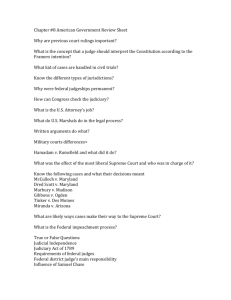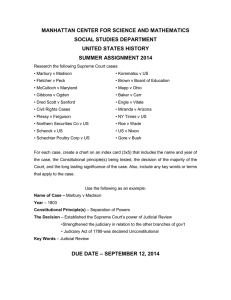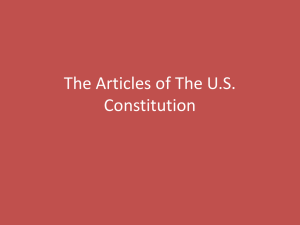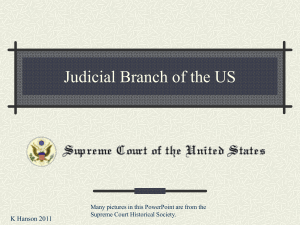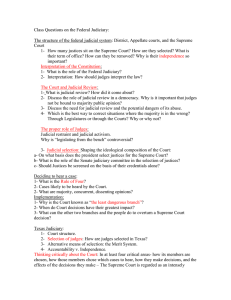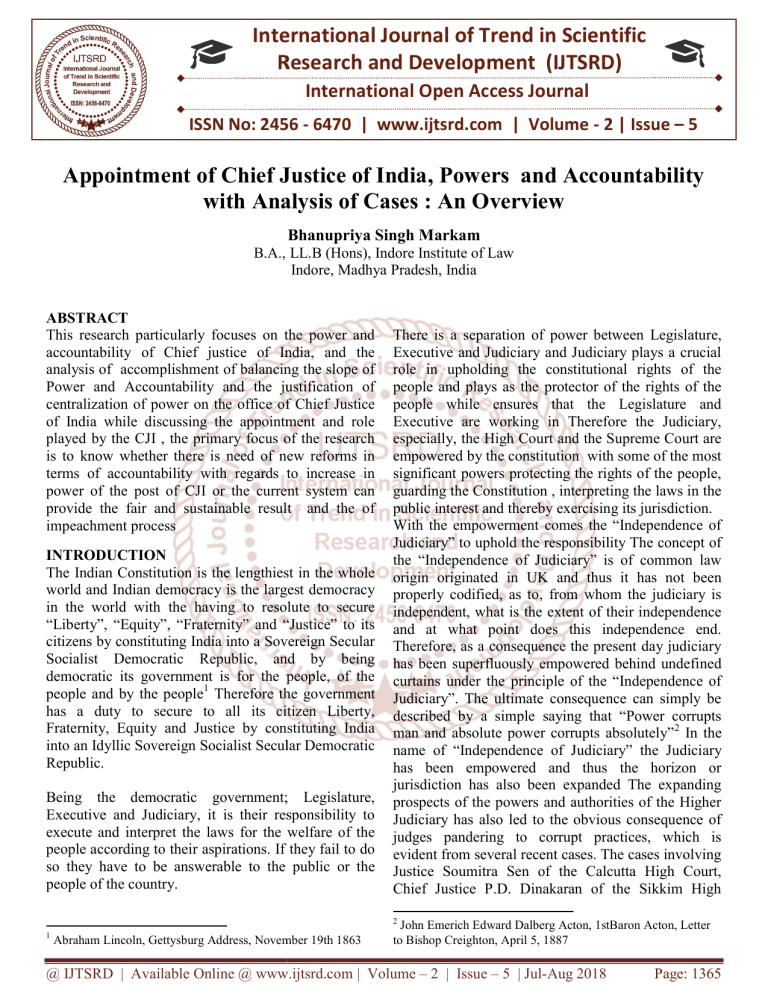
International Journal of Trend in Scientific
Research and Development (IJTSRD)
International Open Access Journal
ISSN No: 2456 - 6470 | www.ijtsrd.com | Volume - 2 | Issue – 5
Appointment
ment of Chief Justice of India, Powers and
d Accountability
with Analysis oof Cases : An Overview
Bhanupriya Singh Markam
B.A., LL.B (Hons), Indore Institute of Law
Indore, Madhya Pradesh, India
ABSTRACT
This research particularly focuses on the power and
accountability of Chief justice of India, and the
analysis of accomplishment of balancing the slope of
Power and Accountability and the justification of
centralization
ion of power on the office of Chief Justice
of India while discussing the appointment and role
played by the CJI , the primary focus of the research
is to know whether there is need of new reforms in
terms of accountability with regards to increase in
powerr of the post of CJI or the current system can
provide the fair and sustainable result and the of
impeachment process
INTRODUCTION
The Indian Constitution is the lengthiest in the whole
world and Indian democracy is the largest democracy
in the world with the having to resolute to secure
“Liberty”, “Equity”, “Fraternity” and “Justice” to its
citizens by constituting India into a Sovereign Secular
Socialist Democratic Republic, and by being
democratic its government is for the people, of the
people and by the people1 Therefore the government
has a duty to secure to all its citizen Liberty,
Fraternity, Equity and Justice by constituting India
into an Idyllic Sovereign Socialist Secular Democratic
Republic.
Being the democratic government; Legislature,
Executive and Judiciary, it is their responsibility to
execute and interpret the laws for the welfare of the
people according to their aspirations. If they fail to do
so they have to be answerable to the public or the
people of the country.
There is a separation
aration of power between Legislature,
Executive and Judiciary and Judiciary plays a crucial
role in upholding the constitutional rights of the
people and plays as the protector of the rights of the
people while ensures that the Legislature and
Executive aree working in Therefore the Judiciary,
especially, the High Court and the Supreme Court are
empowered by the constitution with some of the most
significant powers protecting the rights of the people,
guarding the Constitution , interpreting the laws in the
public interest and thereby exercising its jurisdiction.
With the empowerment comes the “Independence of
Judiciary” to uphold the responsibility The concept of
the “Independence of Judiciary” is of common law
origin originated in UK and thus it has not been
be
properly codified, as to, from whom the judiciary is
independent, what is the extent of their independence
and at what point does this independence end.
Therefore, as a consequence the present day judiciary
has been superfluously empowered behind undefined
undefi
curtains under the principle of the “Independence of
Judiciary”. The ultimate consequence can simply be
described by a simple saying that “Power corrupts
man and absolute power corrupts absolutely” 2 In the
name of “Independence of Judiciary” the Judiciary
Judici
has been empowered and thus the horizon or
jurisdiction has also been expanded The expanding
prospects of the powers and authorities of the Higher
Judiciary has also led to the obvious consequence of
judges pandering to corrupt practices, which is
evident
ent from several recent cases. The cases involving
Justice Soumitra Sen of the Calcutta High Court,
Chief Justice P.D. Dinakaran of the Sikkim High
2
1
Abraham Lincoln, Gettysburg Address, November 19th 1863
John Emerich Edward Dalberg Acton, 1stBaron Acton, Letter
to Bishop Creighton, April 5, 1887
@ IJTSRD | Available Online @ www.ijtsrd.com | Volume – 2 | Issue – 5 | Jul-Aug
Aug 2018
Page: 1365
International Journal of Trend in Scientific Research and Development (IJTSRD) ISSN: 2456-6470
Court and Justice Nirmal Yadav of the Uttarakhand
High Court are all at various stages. The only reason
for all this is the delegation of extraneous powers in
the hands of the judges in the name of independence
and lack of accountability. As Montesquieu says that,
“Constant experience has shown us that every man
invested with power is apt to abuse it, and to carry his
authority until he is confronted with limits’3 . Today
the Higher Judiciary having been enormously
empowered with authority and extended jurisdiction
has started abusing its power, and will continue
abusing it until it’s confronted with limits and is
subjected to accountability.
The present condition is that in a system of
governance built on the principles of Separation of
Powers, Rule of Law and Checks and Balance the
Higher Judiciary is still unchecked and there is no
effective system, authority or institution to judge the
judges for their malfunction and misbehaviour, if
there’s, then the system is so ineffective that in last 64
years since the adoption of our Constitution there
have been no impeachment or disciplinary actions
against even a single one.
In a Democratic country where the protection of rights
, interpretation of law and the organ which is
entrusted with the power of serving “ justice for all”
must be subjected to accountability.
(G) JUDICIAL
ACCOUNTABILITY
BILL
APPROVED
The Judicial Standards and Accountability Bill will
set judicial standards and make judges accountable for
their lapses. It will also mandate that judges of the
high court’s and the Supreme Court declare their
assets and liabilities, including those of their spouses
and dependants. The Union Cabinet has approved the
draft Judicial Standards and Accountability Bill, 2010
that provides for setting up a five-member oversight
committee to deal with complaints against members
of the higher judiciary. Official sources said judges
would also be required to declare their assets and file
an annual return of assets and liabilities. All these
details will be put up on the websites of the Supreme
Court and high courts. It will further require judges
not to have close ties with any member of the Bar,
especially those who practise in the same court. “The
enactment of the Bill will address the growing
concerns regarding the need to ensure greater
3
Montesquieu: The Spirit of Laws: Book 11
accountability of the higher judiciary by bringing in
more transparency, and will further strengthen the
credibility and independence of the judiciary,”
Information and Broadcasting Minister Ambika Soni
told reporters after a meeting of the Union Cabinet.
The proposed oversight committee will be headed by
a former chief justice of India and include the attorney
general, a Supreme Court judge, a chief justice of a
high court and an eminent person nominated by the
President.
OVERSIGHT COMMITTEE
The Bill to replace the Judges Inquiry Act retains its
basic features, contemplates setting up of a national
oversight committee, to be headed by a former Chief
Justice of India, with which the public can lodge
complaints against erring judges, including the Chief
Justice of India and the Chief Justices of the High
Courts. At present, there is no legal mechanism for
dealing with complaints against judges, who are
governed by ‘Restatement of Values of Judicial Life,'
adopted by the judiciary as a code of conduct without
any statutory sanction.
The five-member committee to be appointed by the
President will have a serving judge of the Supreme
Court and a serving High Court judge, both
nominated by the Chief Justice of India; the AttorneyGeneral; and an eminent person nominated by the
President.
SCRUTINY PANELS
On receiving a complaint, the committee will forward
it to a system of scrutiny panels. In the case of a
complaint against a Supreme Court judge, the scrutiny
panel will consist of a former Chief Justice of India
and two sitting Supreme Court judges, and in the case
of a complaint against a High Court judge, the panel
will have a former Chief Justice of the High Court and
two of its sitting judges. The members of the Supreme
Court panel will be nominated by the Chief Justice of
India, and that of the High Court panels by the Chief
Justice of the High Court concerned. The scrutiny
panels will have the powers of a civil court. For
instance, they can call for witnesses and evidence.
They will be required to give their report within three
months to the oversight committee. In the case of a
complaint against a Chief Justice, the oversight
committee itself will conduct the scrutiny. On
receiving the report from the scrutiny panels, the
oversight committee will set up a committee to further
investigate the case. Like the scrutiny panels, the
@ IJTSRD | Available Online @ www.ijtsrd.com | Volume – 2 | Issue – 5 | Jul-Aug 2018
Page: 1366
International Journal of Trend in Scientific Research and Development (IJTSRD) ISSN: 2456-6470
investigation committee will have the powers of a
civil court; it will have the power to frame definite
charges. If the charges are not proved, the
investigation committee can dismiss the case.
Otherwise, it will give a report to the oversight
committee, which can issue an advisory or warning or
recommend minor punishment if the charges are not
too serious. If the charges are serious, the committee
can request the judge concerned to resign. If the judge
does not do so, the oversight committee will forward
the case to the President with an advisory for his
removal. The Bill mandates that judges should not
have close association with individual members of the
Bar and not allow any member of their immediate
family to appear before them in courts. Judges should
not contest any election to any office of club, society
or other association, except those associated with the
law or any court. Further, they should not have any
bias in judicial work or judgments on the basis of
religion, race, caste, sex or place of birth.
(H) CONCLUSION
Corruption in the judiciary is hardly a new
phenomenon, though it has certainly increased over
the years. It is worthwhile however to examine the
reasons for the sudden spate of exposures of judicial
corruption. Having enjoyed enormous powers,
including the power of contempt, without any
accountability, the higher judiciary has over the years;
tread on the toes of many persons and institutions,
particularly the media. Not wanting to suffer
criticism, the judiciary has used its power of contempt
to stifle criticism. More than 50 editors, publishers
and journalists have been issued contempt notices by
the Karnataka High Court for having written stories
about a judicial sex scandal, reportedly involving
three judges of the High Court. Small wonder then,
that the media is enjoying every bit of the juicy
judicial scandals that have exploded. That there has
been corruption in the judiciary for many years one
reason why judges have been treated as demigods in
this country is because of the power of contempt
wielded by them. This is a jurisdiction in which a
judge against whom an allegation has been made can
himself act as the complainant, prosecutor and judge.
The judge can even refuse to allow the maker of the
allegation to prove its truth. The very existence of this
power has been enough to silence the media and
inhibit them from exposing judicial misbehavior or
corruption. The amendment recently moved in
Parliament to make truth a defense in a contempt
action is not an adequate safeguard for the citizens
and the press. As the case involving the journalists
who wrote about the Karnataka sex scandal shows,
though the allegation may be made bona fide and on a
reasonable basis, it may not always be possible to
prove its truth. This could be because the witnesses
are won over or the evidence disappears for some
other reason.4
APPOINTMENT OF CHIEF JUSTICE OF
INDIA
The Chief Justice of India and the Judges of the
Supreme Court are appointed by the President under
clause (2) of Article 124 of the Constitution.
Appointment to the office of the Chief Justice of India
should be of the senior most Judge of the Supreme
Court considered fit to hold the office. The Union
Minister of Law, Justice and Company Affairs would,
at the appropriate time, seek the recommendation of
the outgoing Chief Justice of India for the
appointment of the next Chief Justice of India 5
Whenever there is any doubt about the fitness of
the senior most Judge to hold the office of the
Chief Justice of India, consultation with other
Judges as envisaged in Article 124 (2) of the
Constitution would be made for appointment of
the next Chief Justice of India.
After receipt of the recommendation of the Chief
Justice of India, the Union Minister of Law,
Justice and Company Affairs will put up the
recommendation to the Prime Minister who will
advise the President in the matter of appointment.
APPOINTMENT OF ACTING CHIEF JUSTICE
Appointment of acting Chief Justice is to be made by
the President under Article 126 of the Constitution.
Vacancy in the office of the Chief Justice must be
filled whatever the period of vacancy. In such an
eventuality, the senior most available Judge of the
Supreme Court will be appointed to perform the
duties of the office of the Chief Justice of India. As
soon as the President has approved the appointment,
the Secretary to the Government of India in the
Department of Justice will inform the Chief Justice of
India or in his absence the Judge concerned of the
4
Judicial Accountability in India (July 20, 2018 , 10.20 AM)
http://www.legalservicesindia.com/article/538/JudicialAccountability-in-India.html
5
Memorandum showing the procedure for Appointment of the
Chief Justice Of India and Judges of the supreme court ( July
20, 2018, 02.04 PM)
http://doj.gov.in/sites/default/files/memosc.pdf
@ IJTSRD | Available Online @ www.ijtsrd.com | Volume – 2 | Issue – 5 | Jul-Aug 2018
Page: 1367
International Journal of Trend in Scientific Research and Development (IJTSRD) ISSN: 2456-6470
Supreme Court, and will announce the appointment
and issue the necessary notification in the Gazette of
India.
predisposition of particular Judges, the Chief Justice
may assign cases to those Judges to achieve a
predetermined outcome.
QUALIFICATIONS
He should be a citizen of India.
He should have been for at least five years a Judge
of a High Court or of two or more such courts in
succession. OR
He should have been for at least ten years an
Advocate of a High Court or of two or more such
courts in succession. OR
He should be, in the opinion of the President, a
distinguished jurist.
This means that no minimum age has been
prescribed for his appointment.
A roster declares what work is assigned to High Court
and Supreme Court Judges. ‘Master of the Roster’
refers to the privilege of the Chief Justice to constitute
Benches to hear cases. It is a pre-requisite that this
power must be exercised in a manner is that fair, just
and transparent and in keeping with the high standards
of integrity desired from the office of a Chief Justice
of India.6
He appoints court officials.
He also carries out other general functions relating
to the SC.
Other judges of the Supreme Court are appointed
by the President of India after consulting the CJI
and such other judges of the Supreme Court and
high courts as he deems necessary. Consultation
with the CJI for this purpose is obligatory.
He acts as the President of India if the offices of
both the President and the Vice-President lie
vacant.
ROLE OF CJI
The CJI is the head of the Judiciary of India and the
Supreme Court of India. It is the highest post that can
be achieved by a judge in India.
He allocates cases and appoints constitutional benches
to deal with important cases of law.
He also heads the administrative functions of the
Supreme Court.
Whenever a vacancy is expected to arise in the office
of a Judge of the Supreme Court, the Chief Justice of
India will initiate proposal and forward his
recommendation to the Union Minister of Law,
Justice and Company Affairs to fill up the vacancy.
ADMINISTRATIVE FUNCTIONS:
He allocates matters to other judges of the SC.
He maintains the roster.
The Chief Justice is the “Master of Roster” and has
the authority to allocate the cases to different
Benches/Judges of the Supreme Court. It is also
conceded that adherence to this principle, namely, the
Chief Justice is the Master of Roster, is essentially to
maintain judicial discipline and decorum. It is also
stated that the Chief Justice is first among equals,
meaning thereby all Judges of the Supreme Court are
equal with same judicial power, with Chief Justice as
the senior most Judge. At the same time, it is
contended that this power is not to be used to assert
any superior authority by the Chief Justice and the
power is to be exercised in a manner that is fair, just
and transparent. As the Master of Roster, it is also
conceded that it is the Chief Justice who has to decide
as to which Bench will hear a particular case. The
apprehension expressed is that keeping in view the
CURRENT CONTROVERSY OF JUSTICE
DIPAK MISHRA: AN ANALYSIS
Background
The impeachment notice comes a day after a Supreme
Court bench, headed by Chief Justice Dipak Misra,
dismissed petitions seeking an independent probe into
the death of Judge B H Loya, who was hearing the
Sohrabuddin Sheikh encounter case, stating the death
to be natural and such petitions to be an attack on the
Judiciary.
Brijgopal Harkishan Loya was an Indian judge who
served in a court in the Central Bureau of
Investigation (CBI). He was presiding over the
Sohrabuddin Sheikh case, and allegedly died under
unnatural circumstances on December 1, 2014 in
Nagpur, 15 days before the next hearing when the
verdict was supposed to be given.
The Sohrabuddin Sheikh Encounter case involves the
death of an alleged criminal Sohrabuddin
Anwarhussain Sheikh on November 26, 2005, while
he was in police custody
However,
Vice President and Rajya Sabha Chairperson M
Venkaiah Naidu on April 23, 2018 rejected the
6
W.P. (C) No.789 of 2018
@ IJTSRD | Available Online @ www.ijtsrd.com | Volume – 2 | Issue – 5 | Jul-Aug 2018
Page: 1368
International Journal of Trend in Scientific Research and Development (IJTSRD) ISSN: 2456-6470
impeachment notice submitted by the Opposition
parties against Chief Justice of India Dipak Misra.
Naidu rejected the notice stating that the motion
lacked substantial merit and that it was based on
mere suspicion, conjecture or assumption rather
than factual proof. The decision comes a day after
Naidu held extensive consultations with experts to
determine the legality of the motion.
In a first, seven opposition parties led by the
Indian National Congress had submitted a notice
to the Rajya Sabha Chairman and Vice President,
M Venkaiah Naidu on April 20 for the
impeachment of Chief Justice of India Dipak
Misra on five grounds of ‘misbehavior’.
Key Highlights
The members of Parliament who signed the notice
belong to parties including the Congress, NCP,
CPI-M, CPI, SP and the BSP.
The leaders of these parties earlier met in
Parliament and gave final shape to the notice for
impeachment.
After the meeting, Leader of Opposition Ghulam
Nabi Azad confirmed that the leaders were
moving the notice for impeachment against CJI.
Two parties - Trinamool Congress and the DMK,
which were initially in favour of the impeachment
against the CJI, are no longer a part of it.
However, Vice President Venkaiah Naidu rejected the
impeachment notice submitted by the opposition.7
This was the first-ever time that an impeachment
notice was filed against a sitting CJI.
IMPEACHMENT PROCEDURE
The impeachment notice of an SC judge or CJI
can be moved in either House of the Parliament.
However, it should be issued by at least 50 MPs
from the Rajya Sabha and 100 MPs from the Lok
Sabha.
The impeachment notice has to be handed over
either to the Speaker of Lok Sabha if it is from the
lower house MPs or to the Chairman of Rajya
Sabha if it is from the upper house MPs. The
7
Rajya Sabha Chairman Venkaiah Naidu rejects impeachment
notice against CJI Dipak Misra (July 21, 2018, 11.11AM)
https://www.jagranjosh.com/current-affairs/opposition-submitsmotion-to-impeach-chief-justice-dipak-misra-1524289344-1
Chairman of the Rajya Sabha is also the Vice
President of India.
Once the motion is submitted to the Speaker of
Chairman, the person concerned will have to
constitute a three-member committee to
investigate the charges leveled against the
Supreme Court judge.
The three-member committee will consist of a
senior Supreme Court judge, a High Court judge
and a ‘distinguished jurist’ who has been
appointed as a Supreme Court judge by the
President of India.
The three-member committee has to support the
motion for it to be sent back to the House where it
was introduced.
In the House, it has to be discussed and passed
with a special majority — not less than two-thirds.
This means, in case of a full House, at least 364
Members should have voted for the motion in the
Lok Sabha, and 164 Members in the Rajya Sabha.
Once the motion is passed by the house it was
introduced in, it has to be passed on to the other
House where it again needs to be passed by
special majority.
Once it is passed by both the Houses of
Parliament, then the President can be approached
to remove the Chief Justice of India.
CONCLUSION
One must realize that in countries like India the
judiciary is relied upon by the citizenry to solve many
of their difficulties and therefore consistent standards
of accountability that give the Indian judiciary this
strength are of utmost importance. The moment
judicial accountability wavers it creates a vacuum
where, both the political class and vested interests
would take advantage of the conundrum to further
reduce the credibility of the judiciary whereas, an
accountable judicial institution can only lead to a
stable political atmosphere as well as a far more
efficient system of governance. However, it is also
acknowledged that judicial accountability if stretched
too far can seriously hamper judicial independence
and thus it is essential that we strike the right balance
between the two.
Certain situations like the allegations on the CJI may
arise question on the integrity of the court of law and
also the faith of people in the legal system may
hinder, “the combination of absolute power, complete
opacity, and no accountability in the office of Chief
Justice basically means that for the institution to
@ IJTSRD | Available Online @ www.ijtsrd.com | Volume – 2 | Issue – 5 | Jul-Aug 2018
Page: 1369
International Journal of Trend in Scientific Research and Development (IJTSRD) ISSN: 2456-6470
survive, every CJI must be utterly incorruptible,
absolute impartial, and beyond reproach.” The
researcher also believe that based on the US model to
improve the undisputedly ineffective mode of
impeachment the Lokh Sabha in case of 2/3rd
majority should be empowered to impeach the sitting
judge there and then, and in case of a 2/3rd majority
in the Rajya Sabha the Judge should be convicted for
his alleged offence. This will make the process more
expeditious and transparent and also make judges
think twice before usurping their “Independence” to
break the trust of this country’s true Sovereign.
@ IJTSRD | Available Online @ www.ijtsrd.com | Volume – 2 | Issue – 5 | Jul-Aug 2018
Page: 1370

